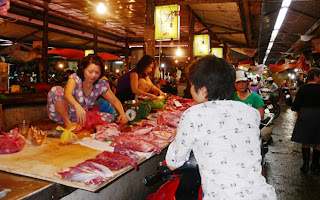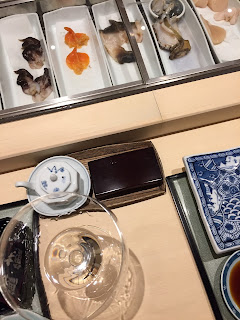Groupie Feature by Grace Ho: VIETNAMESE CUISINE AND A COOKING CLASS
No visit to Vietnam would be complete without participating in a cooking class to learn about the flavours in Vietnamese cuisine which are unique, delicate, exotic, complex, fresh and light. Their food reflects the strong influences of Cantonese cooking, having been occupied by the Chinese for 1,000 years, as well as Thai and Malay influences, with a bit of French twist having been under their control centuries later for a 100 years.
I joined the Hanoi Cooking Centre’s half day cooking class. The school is run by an Australian ex-pat, Tracey, who had previously taught cooking in her homeland. There were individual cooking stations for 2 people for hands-on lessons. The dishes prepared during the lesson were enjoyed at the end of the class.
The class started with a trip to the market where the locals buy their food. It is unlike any market found in North American. At the entrance to the market we stopped at a small grocery stall to learn about the packages of dried rice vermicelli, noodles, sauces, dehydrated mushrooms, etc and they also had various eggs on display. The most interesting was the “balut”, a fertilized duck egg which is just about to be hatched. The Vietnamese prefer the “balut” matured to the point when the embryo is recognizable as a baby duck. Tracey, our instructor, purchased 2 to for us to taste during our class.
Entering the market was quite an experience, each section sells something different. The meat section sold pork, goat, lamb and beef, all displayed on an open unrefridgerated counter. The woman selling the meat sits bare feet right on the counter. The locals shopping for the meat would ride their motor-cycles right into the market and up to the counter to make their purchase.
 THE MEAT COUNTER
THE MEAT COUNTER
As nothing is wasted in Vietnam, the next section displayed various organ meats like lungs, hearts, livers, intestines, bladder of pigs and cows, duck tongues, kidneys and animal blood. Here we also saw a yellowish pile of live larvae. A bag of larvae was purchased for us to taste.
 NOTHING IS WASTED
NOTHING IS WASTED
Fortunately, the next area was not used at this time of the month as this was where dog meat is sold during the second part of the lunar month when you would see dog meat hanging. It is commonly eaten in Vietnam and is believed to raise the libido of men!
There was a seafood area where the catch of the day are kept live in large plastic buckets. Occasionally, a fish would jump out of the bucket and be seen flapping away on the ground. Adjacent to this was the bounty from the paddy fields, the paddy crabs, eels, frogs and snails. A woman was squatting in her little stall with a basket full of frogs. She would grab a frog by its hind-legs, give it a hard whack on the counter and proceed to slit the frog open to clean it for her customers.
 SNAILS FROM THE PADDY FIELDS
SNAILS FROM THE PADDY FIELDS
Finally, we came to counters that were piled high with fresh vegetable and herbs.
Back at the school we learnt to make some of the Vietnamese Street Foods for which Hanoi is famous. Interestingly, in Vietnamese food, you will find the balance of 5 flavours: sweet and salty, spicy, sour and bitter. This creates the delicate flavours of the food which is laced with limes and lemongrass, fresh chilies, vinegars, coconut milk and the signature taste of so many Vietnamese dishes, the light and pungent fermented fish sauce, “Nuoc Nam”. Fresh vegetables and herbs are the main ingredients of every dish.
The “balut” was boiled and then the whole egg served with salt and pepper or lime juice. The beak, eyes and shape of the duckling was clearly recognizable. All the contents of the egg is eaten. The larvae were stir fried with some seasoning. Although I am adventurous with food, I just could not make myself taste either dish. Both dishes are definitely not for the faint of heart and I was the only one in the class who fell into this category.
We ended our class with a delicious lunch of the dishes we prepared:
Pho Bo – Beef Noodle soup, West Lake Prawn Cakes, Vegetable pickle, Pho Cuon – Beef Rice Noodle rolls, Green Papaya Salad and finally a desert, Banana Che.
The cooking class was an amazing experience and a fun way to get some insight into Vietnamese food.
I joined the Hanoi Cooking Centre’s half day cooking class. The school is run by an Australian ex-pat, Tracey, who had previously taught cooking in her homeland. There were individual cooking stations for 2 people for hands-on lessons. The dishes prepared during the lesson were enjoyed at the end of the class.
The class started with a trip to the market where the locals buy their food. It is unlike any market found in North American. At the entrance to the market we stopped at a small grocery stall to learn about the packages of dried rice vermicelli, noodles, sauces, dehydrated mushrooms, etc and they also had various eggs on display. The most interesting was the “balut”, a fertilized duck egg which is just about to be hatched. The Vietnamese prefer the “balut” matured to the point when the embryo is recognizable as a baby duck. Tracey, our instructor, purchased 2 to for us to taste during our class.
Entering the market was quite an experience, each section sells something different. The meat section sold pork, goat, lamb and beef, all displayed on an open unrefridgerated counter. The woman selling the meat sits bare feet right on the counter. The locals shopping for the meat would ride their motor-cycles right into the market and up to the counter to make their purchase.
 THE MEAT COUNTER
THE MEAT COUNTERAs nothing is wasted in Vietnam, the next section displayed various organ meats like lungs, hearts, livers, intestines, bladder of pigs and cows, duck tongues, kidneys and animal blood. Here we also saw a yellowish pile of live larvae. A bag of larvae was purchased for us to taste.
 NOTHING IS WASTED
NOTHING IS WASTEDFortunately, the next area was not used at this time of the month as this was where dog meat is sold during the second part of the lunar month when you would see dog meat hanging. It is commonly eaten in Vietnam and is believed to raise the libido of men!
There was a seafood area where the catch of the day are kept live in large plastic buckets. Occasionally, a fish would jump out of the bucket and be seen flapping away on the ground. Adjacent to this was the bounty from the paddy fields, the paddy crabs, eels, frogs and snails. A woman was squatting in her little stall with a basket full of frogs. She would grab a frog by its hind-legs, give it a hard whack on the counter and proceed to slit the frog open to clean it for her customers.
 SNAILS FROM THE PADDY FIELDS
SNAILS FROM THE PADDY FIELDSFinally, we came to counters that were piled high with fresh vegetable and herbs.
Back at the school we learnt to make some of the Vietnamese Street Foods for which Hanoi is famous. Interestingly, in Vietnamese food, you will find the balance of 5 flavours: sweet and salty, spicy, sour and bitter. This creates the delicate flavours of the food which is laced with limes and lemongrass, fresh chilies, vinegars, coconut milk and the signature taste of so many Vietnamese dishes, the light and pungent fermented fish sauce, “Nuoc Nam”. Fresh vegetables and herbs are the main ingredients of every dish.
The “balut” was boiled and then the whole egg served with salt and pepper or lime juice. The beak, eyes and shape of the duckling was clearly recognizable. All the contents of the egg is eaten. The larvae were stir fried with some seasoning. Although I am adventurous with food, I just could not make myself taste either dish. Both dishes are definitely not for the faint of heart and I was the only one in the class who fell into this category.
We ended our class with a delicious lunch of the dishes we prepared:
Pho Bo – Beef Noodle soup, West Lake Prawn Cakes, Vegetable pickle, Pho Cuon – Beef Rice Noodle rolls, Green Papaya Salad and finally a desert, Banana Che.
The cooking class was an amazing experience and a fun way to get some insight into Vietnamese food.


Comments
Post a Comment